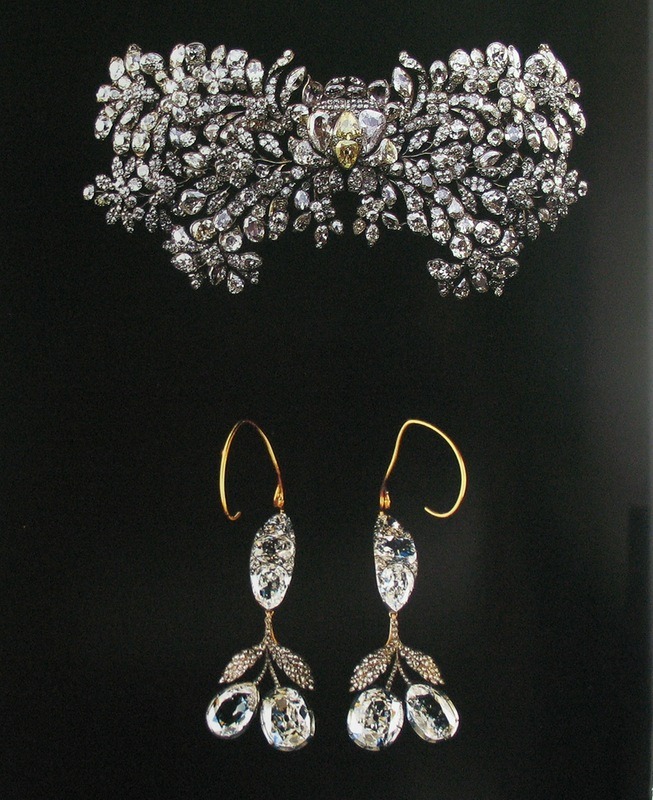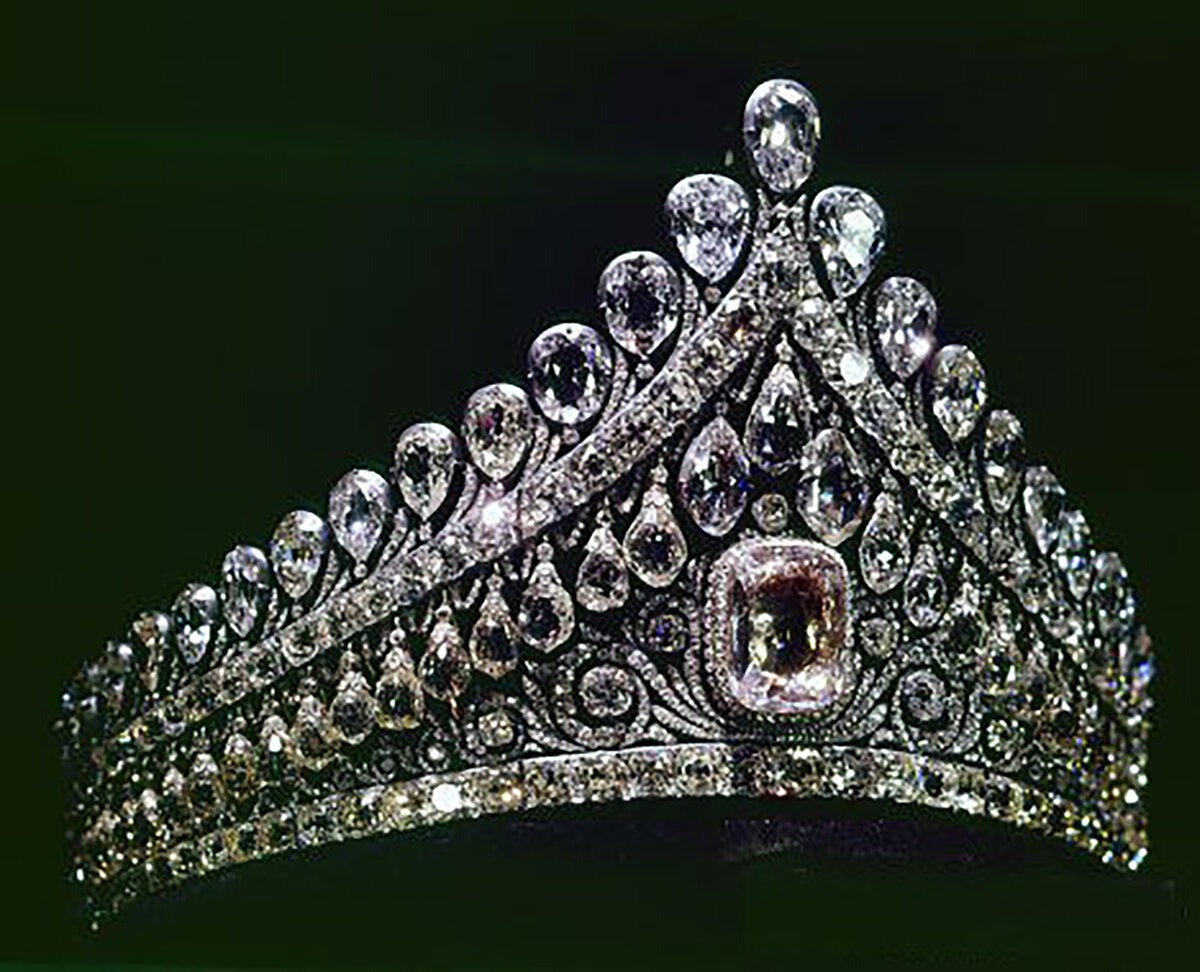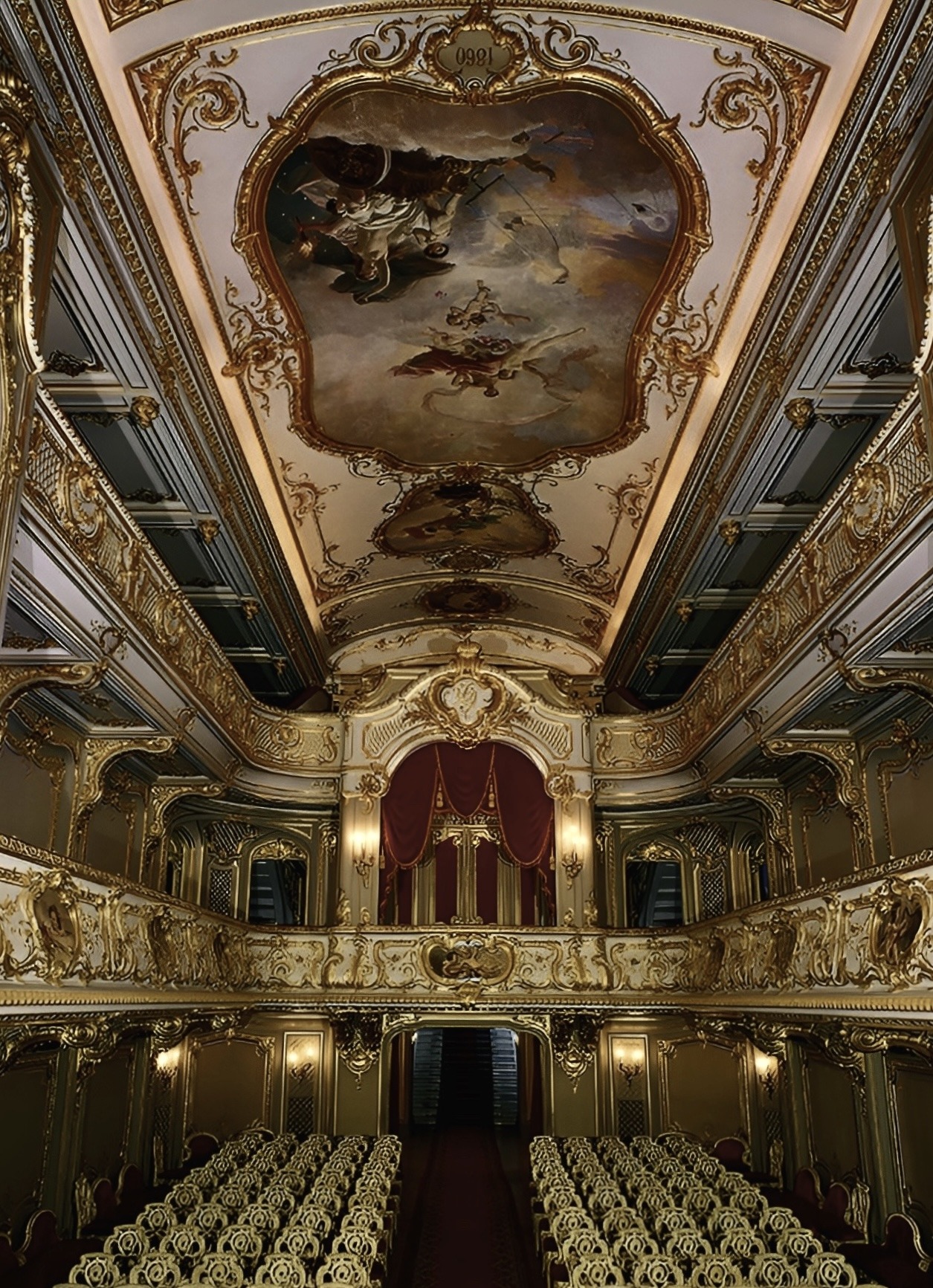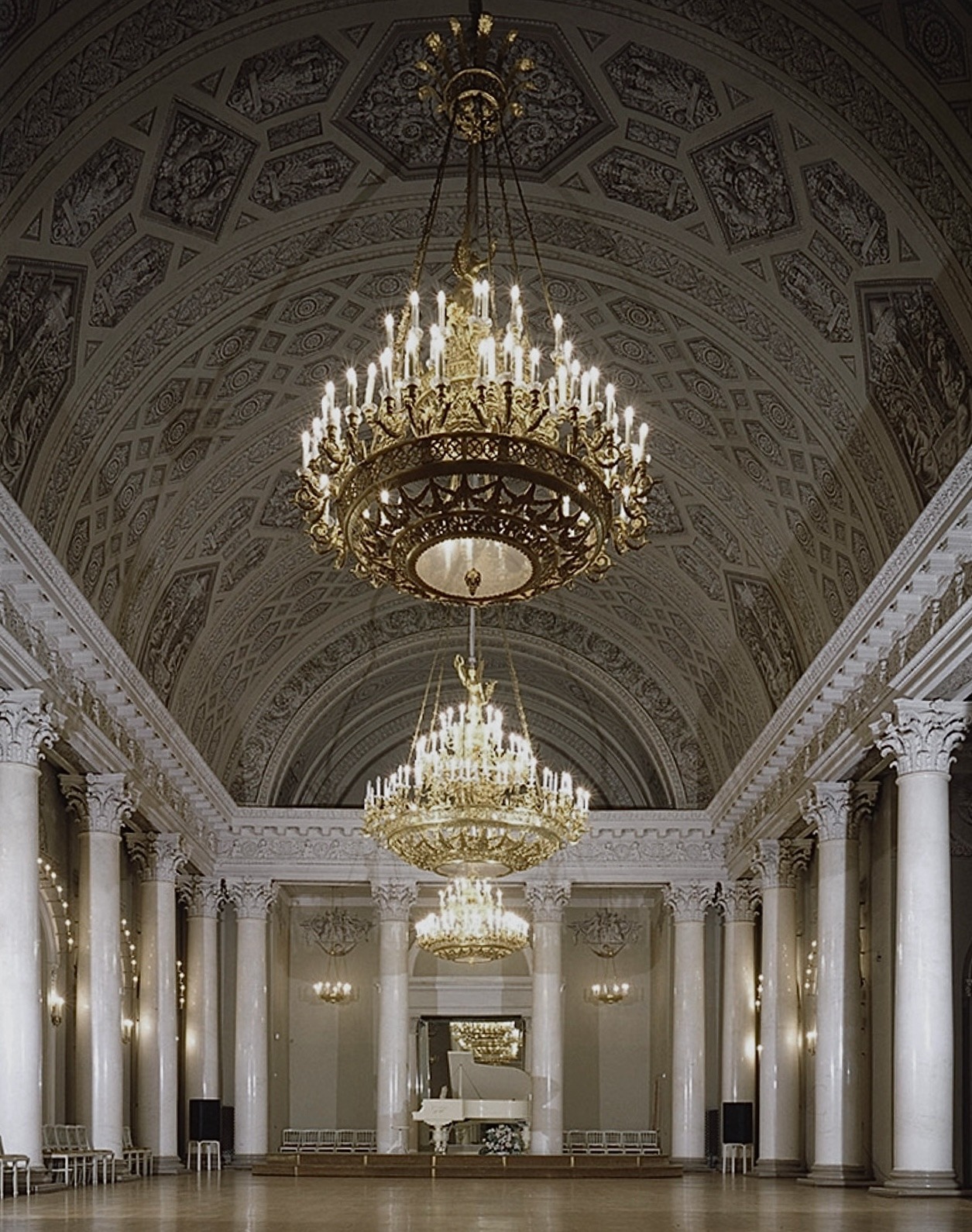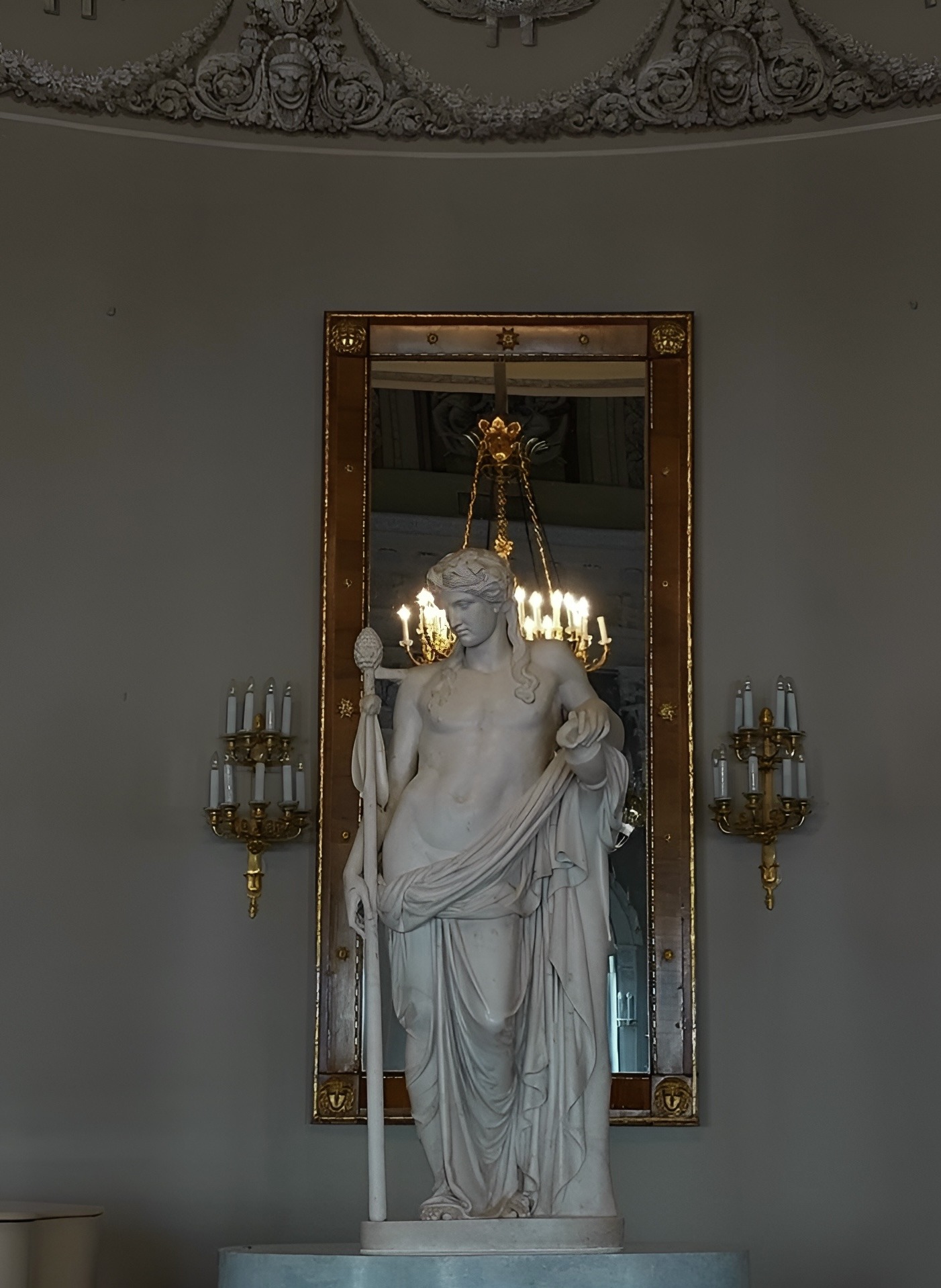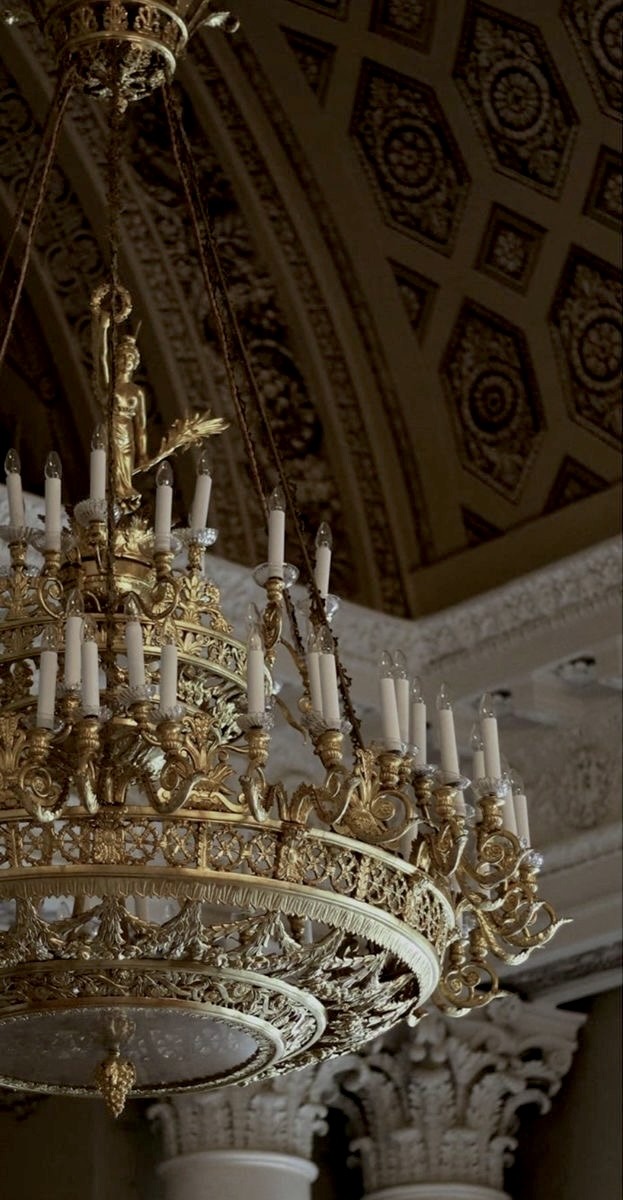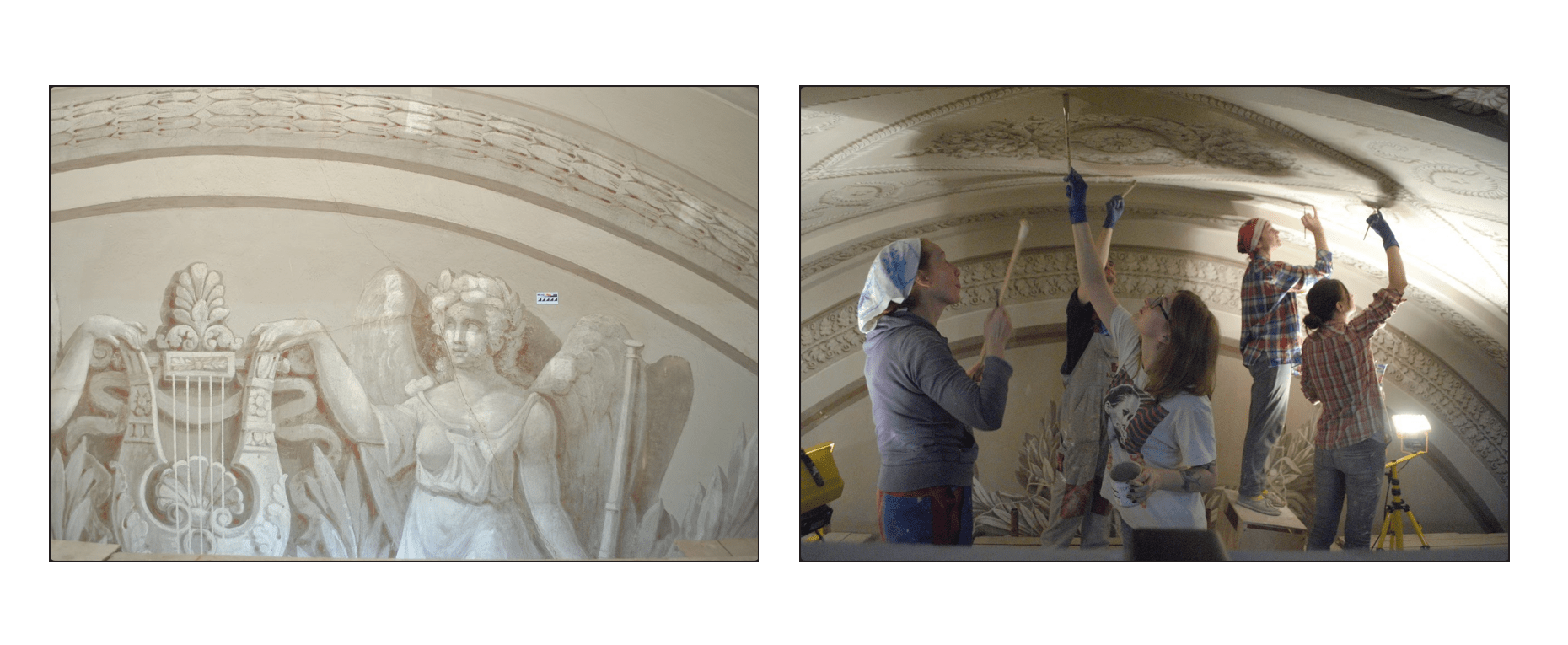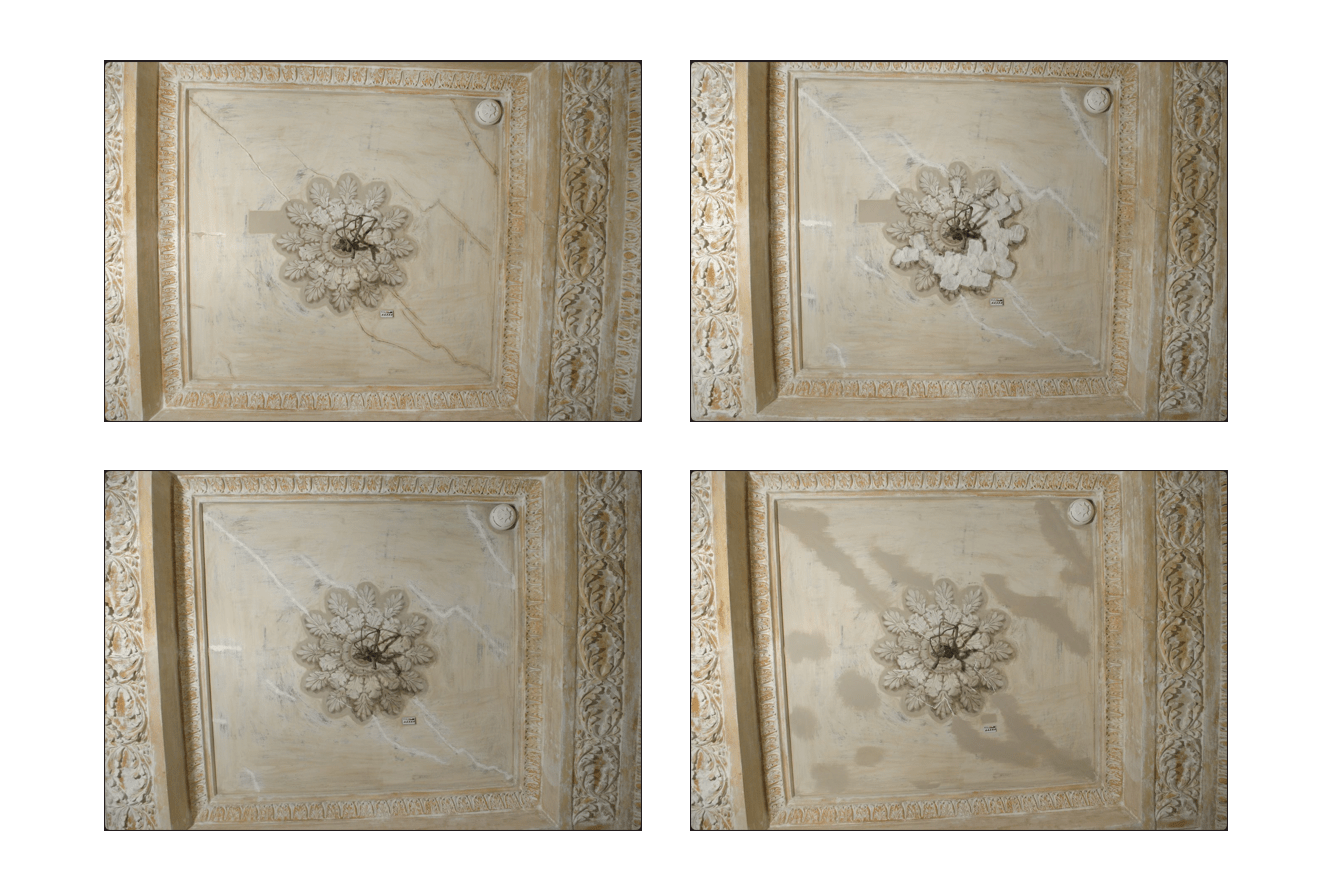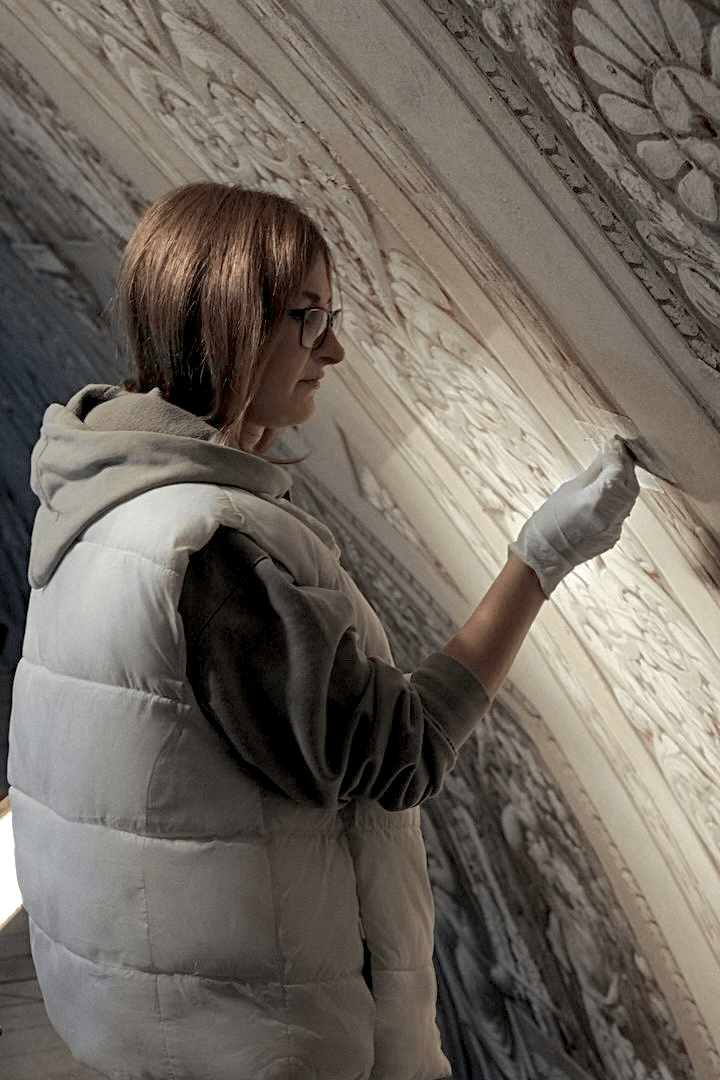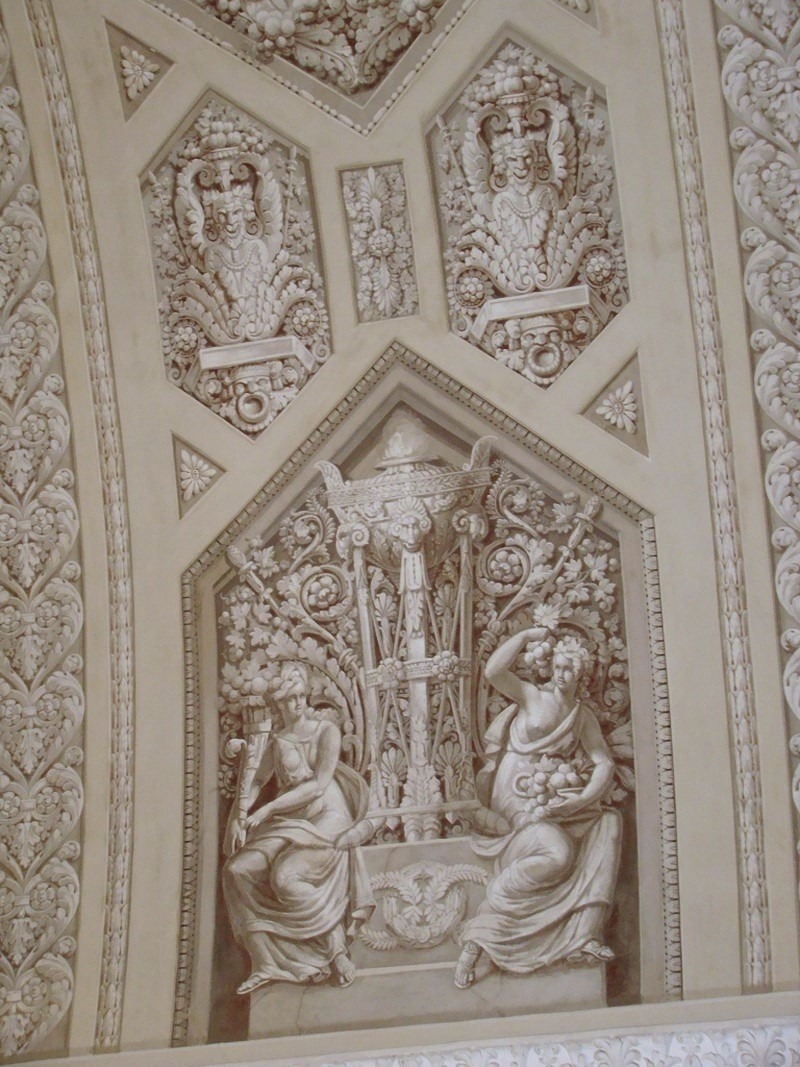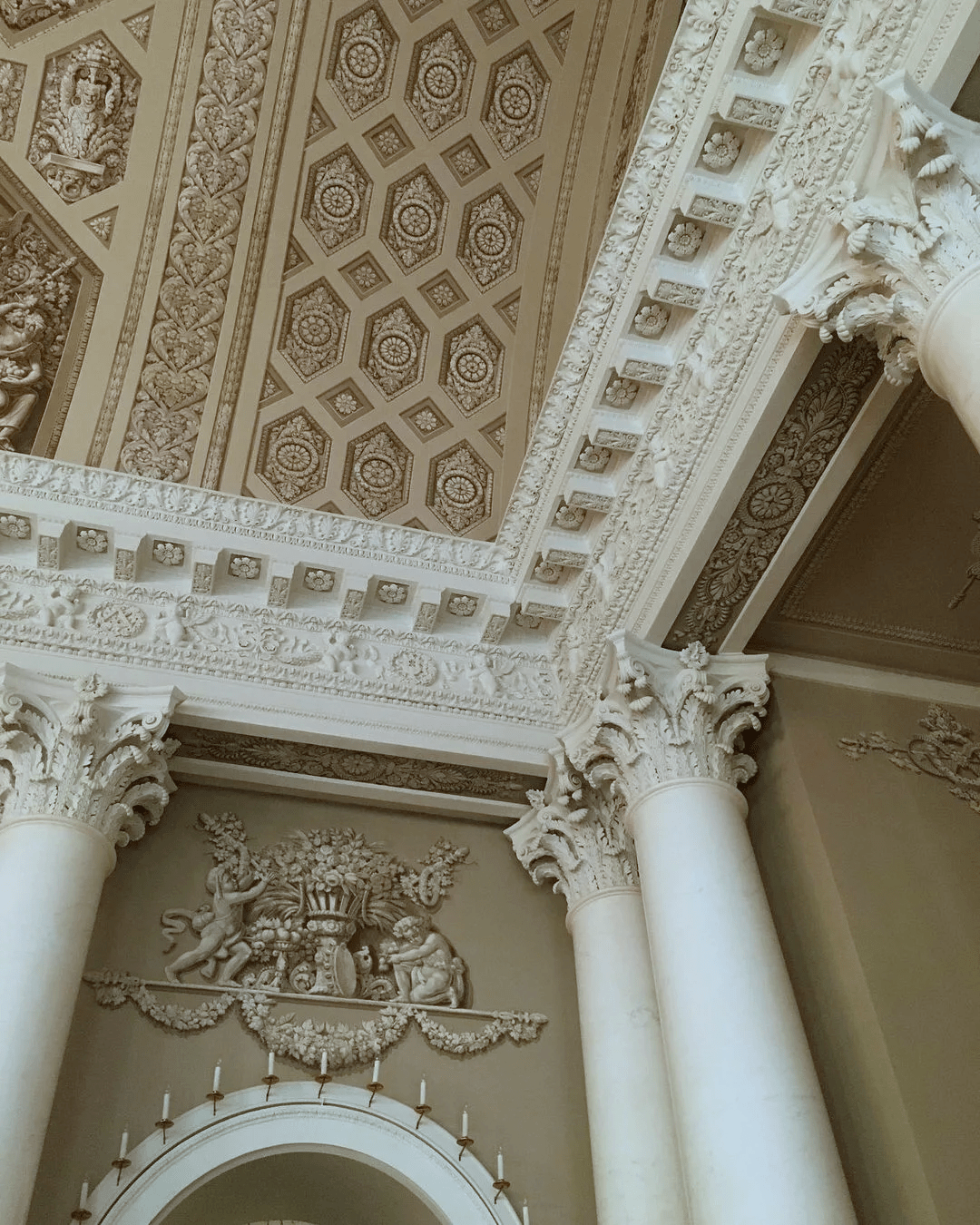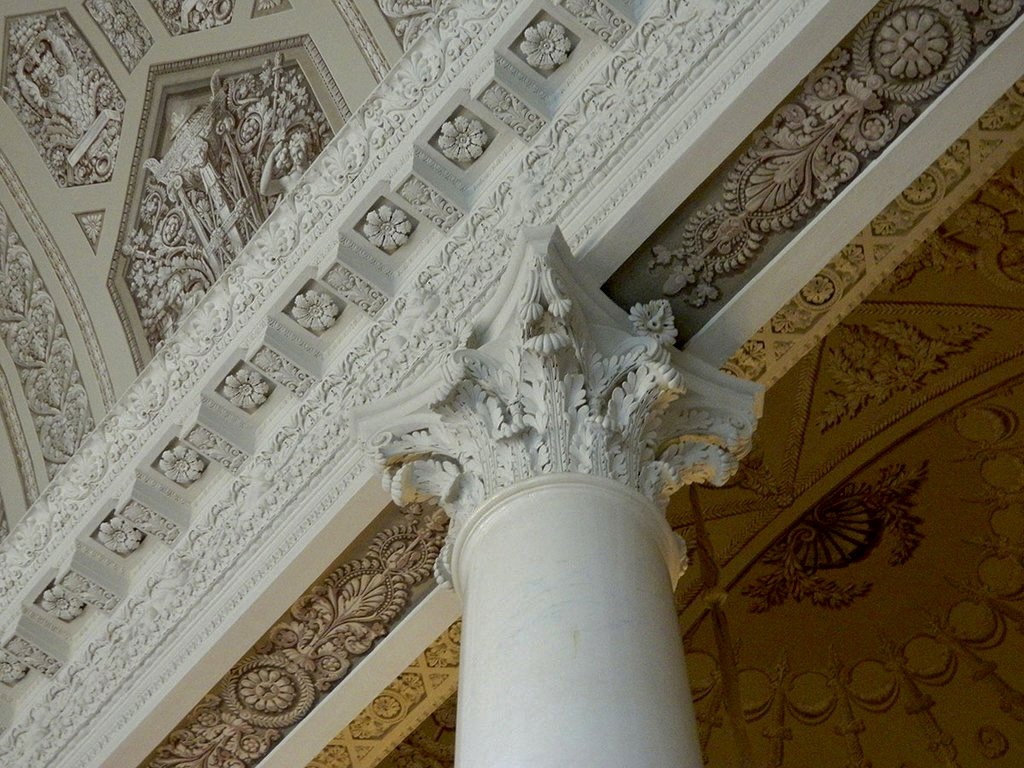Yusupov Palace
The interior is decorated with picturesque monochrome ornamental and figurative compositions on antique themes

The restoration of the interior paintings of the White Boudoir Hall of the Yusupov Palace. Restoration of the ceiling vault, caissons, lunettes and architraves. Emergency reinforcement of the painting layer and ground, removal of surface contaminants, sealing of joints, gaps and cracks, injection, removal and extraction of interlayer efflorescence, elimination of deformations, application of lost ground, tinting, recreation. creation of painting cripples, creation of etalons and sketches.
The mystery of the
Yusupov Palace cellars
Museums and palaces are not only full of real treasures, works of art and historical artefacts, but also keep numerous secrets and mysteries. They excite the imagination and create a special mystical atmosphere, immersion in which leaves unforgettable impressions. The palace of the ancient princely Yusupov family, located on the Moika embankment, is no exception; it keeps not only magnificent treasures and unique works of art, but also a dark secret. It is famous for the fact that Grigory Rasputin was murdered here.
There were four assassins, and in their crime they saw a historic mission – to cleanse the reputation of the imperial family and protect the throne.
German Princess Maria Eleonora of Mecklenburg-Schwerin, who became Princess Maria Pavlovna when she married, a cousin of the last Russian Emperor, was one of the conspirators. By the way, it was her famous Vladimir tiara that after the revolution was sold to the wife of the English King George V – Maria Tekskoy. Thus, later on, the tiara became one of the favourite jewellery of Elizabeth II Queen of Great Britain.
Dissatisfied with the rise of Rasputin and his influence on the Emperor was a lot. And in 1916, several people, including the brother of Princess Maria Pavlovna – Dmitry Pavlovich and Prince Felix Yusupov, prepared the murder of Rasputin. In the vaulted dining room, the victim was fed cakes stuffed with potassium cyanide. By the way, the poison did not work on him. Nor did a point-blank shot kill him. Mortally wounded in the chest imperial favourite almost strangled Yusupov, when he managed to escape. Only the fourth bullet, hit in the neck, knocked Rasputin off his feet. After another shot in the head, he was still breathing, and the conspirators, loading the body in the car, drove him to the Malaya Nevka and dumped in the ice hole.
Treasures of
the Yusupov family
Prince Yusupov was not just a wealthy man, but defiantly rich. However, the Yusupov family was characterised not only by its wealth, but also by its passion for collecting, the subject of which were rare and often fabulously expensive paintings, sculptures and works of decorative and applied art.
In the Hall of Jewels, for example, there are many framed mirrors with mouldings and gilding. They are placed opposite each other and create a mirror corridor of reflections. In the same hall there is a real work of art – a cabinet decorated with precious stones. Fairytale birds lurk on branches whose fruits and flowers sparkle – these are precious stones.
Contemporaries recall endless enfilades of rooms literally littered with treasures. On tables inlaid with mother-of-pearl and ivory, mantelpieces, secretaries, there were snuff boxes, mirrors, jade and malachite jewellery boxes, and priceless statuettes: a Venus carved from a solid sapphire, a ruby Buddha and a bronze black man with a basket of diamonds.
Speaking of statues, the story of the ruby Buddha dates back to the 15th century during the Ming dynasty. The statuette was in the Summer Palace in Beijing until 1860, when the city and the palace were looted during the Second Opium War.
Prince Felix Yusupov bought the statuette and later, during the Revolution, he took it from the family palace and sold it, along with a sapphire Venus, to the jewellery house Cartier.
Cartier made a glass, gold-finished case for the Buddha and added a jadeite pedestal, a ruby belt and a border on the garment.
The 15th century Buddha, carved from 70-plus carats of Burmese Ruby, was valued at $4.3 million.
A four-inch sapphire statuette of the goddess Venus, standing on a large spinel intaglio encrusted with diamonds with the image of Medusa Strozzi on the underside, was also sold to Cartier. One version of the statuette’s history suggests that Catherine the Great gave it to her alleged lover, Prince Nikolai Yusupov (Felix Yusupov’s great-great-great-grandfather); however, there are no official documents confirming how the sculpture that became known as the Blue Venus came to be in the collection of the Yusupov family. The statuette was sold at a Christie’s auction in 2009 to an anonymous buyer.
No less impressive were the huge canvases of famous artists: Boucher, Watteau, Rembrandt, Fragonard and other great artists.
In 1917, the Yusupov family left St Petersburg, vainly expecting to return soon, taking with them only a relatively insignificant amount of money. And the treasures are carefully packed and hidden in several specially equipped hiding places.
After the revolution, in 1918, an Extraordinary Commission worked in the palace on the Moika, searching for treasures, some of the caches were found, for example, the vaults of sculptures and paintings containing hundreds of canvases of famous world masters that had not found a place in the art galleries and halls, a gold dinner set for 120 people, 70 chests of silver, a priceless collection of musical instruments and more than 100 manuscripts of great men, enamel and gold snuff boxes, diamond brooches and necklaces, including Marie Antoinette’s personal jewellery, diamond-encrusted ashtrays and jeweled boxes made of amethysts, topaz and jade set in gold.
However, most of the treasures could not be found. For example, they could not find the unique pearl “Peregrina” estimated at millions of dollars. It turned out that Yusupov managed to take it out of the country and sell it to a jeweller in Geneva in 1953. The last time the pearl “appeared in public” was in 1989, when it was sold to an anonymous buyer at a Christie’s auction.
The palace
The construction of the palace was started by the famous architect J.-B. Vallen-Delamotte in 1760. The building was repeatedly rebuilt, but its facade retained its classical form. In the 19th century architects A.Mikhailov, I.Monighetti and A.Stepanov created an inimitable ensemble of interiors characterised by a variety of decoration and architectural styles.
There were halls for performances – the White Pillar Hall, a home theatre that could seat up to 180 spectators, a dance hall, a musical drawing room, Chekhonin’s drawing room and the Great Hall, as well as greenhouses with rare plants. The blue drawing room is replaced by the green one, the red one by the Moorish one, the white one by the buffet room and the Grand Rotunda, and the billiard room by the porcelain boudoir.
The architectural monument turned out to be paradoxical. On the one hand, it is a crime scene, and on the other hand, a masterpiece of architecture and applied art.
Under the Yusupovs, the palace became not just a luxurious mansion, but a kind of standard of fashionable interiors in the 19th century.
After the revolution, the palace became a museum, although it lost most of its collections, whose exhibits were sold, lost or transferred to the Hermitage. Nowadays you can visit this amazing building and feel the atmosphere of aristocratic salons of the century before last.
The White Pillar Hall
On the first floor of the north-eastern part of the building is the White Column Hall of the Yusupov Palace. It appeared during the radical reconstruction of the palace in the 1830s, undertaken by Yusupov immediately after the purchase of the estate. The work was carried out according to the design of A.A. Mikhailov II. The architect extensively reconstructed the palace building, significantly increasing its size: on the eastern side there appeared a three-storey building with a passage arch on the central axis and a facade facing the embankment. In the mezzanine of the new building, the architect placed the largest hall of the new palace, the Banquet Hall, decorated in the Classicist style.
The rectangular volume of the hall is oriented from west to east, along the front facade, with a deep exedra in the centre of the southern wall. The main volume is covered with a box (cylindrical) vault. Around the perimeter of the hall are twenty-four columns, twinned at the corners, finished in white artificial marble, with Corinthian capitals, straight fusts and profiled bases. On the west and east sides of the hall there are balconies above the columns.
The interior is decorated with picturesque monochrome ornamental and figurative compositions on antique themes in the technique of grisaille by Fridolino Toricelli (ornamental painter, decorative artist, sculptor of Italian origin). The ceiling and tympans of the vault, the vault and walls of the niche with a semi-circular vault, the walls in the inter-window planes are decorated in this way. Seven semi-circular windows of the northern wall are decorated with stylised platbands with sculptural decoration in the form of rosettes. On the west and east sides of the exedra there are low rooms separated from the main part by arched openings.
RESTAURATION MONUMENTAL TEMPERA GLUE PAINTING OF THE WHITE PILLAR HALL. YUSUPOV PALACE
An object of cultural heritage of federal significance.
The restoration of the interior paintings in the White Pillar Hall of the Yusupov Palace included restoration of the ceiling vault, caissons, lunettes and architraves. I and my colleagues carried out conservation of the painting layer and ground, removal of surface contaminants, sealing of joints, gaps and cracks, injection, removal and extraction of interlayer efflorescence, elimination of deformations, application of lost ground, tinting, recreation. Making of painting cripples, creation of etalons and sketches.
I am proud that I have had the privilege of restoring such an outstanding architectural monument and contributing to the preservation of cultural heritage. The building with such a rich history now has murals made by my hand for generations to come to see.
The restoration of the interior paintings in the White Pillar Hall of the Yusupov Palace included restoration of the ceiling vault, caissons, lunettes and architraves. I and my colleagues carried out conservation of the painting layer and ground, removal of surface contaminants, sealing of joints, gaps and cracks, injection, removal and extraction of interlayer efflorescence, elimination of deformations, application of lost ground, tinting, recreation. Making of painting cripples, creation of etalons and sketches.
BLOG
The mystery of the Yusupov Palace cellars
Museums and palaces are not only full of real treasures, works of art and historical artefacts, but also keep numerous secrets and mysteries. They excite the imagination and create a special mystical atmosphere, immersion in which leaves unforgettable impressions. The palace of the ancient princely Yusupov family, located on the Moika embankment, is no exception; it keeps not only magnificent treasures and unique works of art, but also a dark secret. It is famous for the fact that Grigory Rasputin was murdered here.
There were four assassins, and in their crime they saw a historic mission – to cleanse the reputation of the imperial family and protect the throne.
German Princess Maria Eleonora of Mecklenburg-Schwerin, who became Princess Maria Pavlovna when she married, a cousin of the last Russian Emperor, was one of the conspirators. By the way, it was her famous Vladimir tiara that after the revolution was sold to the wife of the English King George V – Maria Tekskoy. Thus, later on, the tiara became one of the favourite jewellery of Elizabeth II Queen of Great Britain.
Dissatisfied with the rise of Rasputin and his influence on the Emperor was a lot. And in 1916, several people, including the brother of Princess Maria Pavlovna – Dmitry Pavlovich and Prince Felix Yusupov, prepared the murder of Rasputin. In the vaulted dining room, the victim was fed cakes stuffed with potassium cyanide. By the way, the poison did not work on him. Nor did a point-blank shot kill him. Mortally wounded in the chest imperial favourite almost strangled Yusupov, when he managed to escape. Only the fourth bullet, hit in the neck, knocked Rasputin off his feet. After another shot in the head, he was still breathing, and the conspirators, loading the body in the car, drove him to the Malaya Nevka and dumped in the ice hole.
Treasures of the Yusupov family
Prince Yusupov was not just a wealthy man, but defiantly rich. However, the Yusupov family was characterised not only by its wealth, but also by its passion for collecting, the subject of which were rare and often fabulously expensive paintings, sculptures and works of decorative and applied art.
In the Hall of Jewels, for example, there are many framed mirrors with mouldings and gilding. They are placed opposite each other and create a mirror corridor of reflections. In the same hall there is a real work of art – a cabinet decorated with precious stones. Fairytale birds lurk on branches whose fruits and flowers sparkle – these are precious stones.
Contemporaries recall endless enfilades of rooms literally littered with treasures. On tables inlaid with mother-of-pearl and ivory, mantelpieces, secretaries, there were snuff boxes, mirrors, jade and malachite jewellery boxes, and priceless statuettes: a Venus carved from a solid sapphire, a ruby Buddha and a bronze black man with a basket of diamonds.
Speaking of statues, the story of the ruby Buddha dates back to the 15th century during the Ming dynasty. The statuette was in the Summer Palace in Beijing until 1860, when the city and the palace were looted during the Second Opium War.
Prince Felix Yusupov bought the statuette and later, during the Revolution, he took it from the family palace and sold it, along with a sapphire Venus, to the jewellery house Cartier.
Cartier made a glass, gold-finished case for the Buddha and added a jadeite pedestal, a ruby belt and a border on the garment.
The 15th century Buddha, carved from 70-plus carats of Burmese Ruby, was valued at $4.3 million.
A four-inch sapphire statuette of the goddess Venus, standing on a large spinel intaglio encrusted with diamonds with the image of Medusa Strozzi on the underside, was also sold to Cartier. One version of the statuette’s history suggests that Catherine the Great gave it to her alleged lover, Prince Nikolai Yusupov (Felix Yusupov’s great-great-great-grandfather); however, there are no official documents confirming how the sculpture that became known as the Blue Venus came to be in the collection of the Yusupov family. The statuette was sold at a Christie’s auction in 2009 to an anonymous buyer.
No less impressive were the huge canvases of famous artists: Boucher, Watteau, Rembrandt, Fragonard and other great artists.
In 1917, the Yusupov family left St Petersburg, vainly expecting to return soon, taking with them only a relatively insignificant amount of money. And the treasures are carefully packed and hidden in several specially equipped hiding places.
After the revolution, in 1918, an Extraordinary Commission worked in the palace on the Moika, searching for treasures, some of the caches were found, for example, the vaults of sculptures and paintings containing hundreds of canvases of famous world masters that had not found a place in the art galleries and halls, a gold dinner set for 120 people, 70 chests of silver, a priceless collection of musical instruments and more than 100 manuscripts of great men, enamel and gold snuff boxes, diamond brooches and necklaces, including Marie Antoinette’s personal jewellery, diamond-encrusted ashtrays and jeweled boxes made of amethysts, topaz and jade set in gold.
However, most of the treasures could not be found. For example, they could not find the unique pearl “Peregrina” estimated at millions of dollars. It turned out that Yusupov managed to take it out of the country and sell it to a jeweller in Geneva in 1953. The last time the pearl “appeared in public” was in 1989, when it was sold to an anonymous buyer at a Christie’s auction.
The palace
The construction of the palace was started by the famous architect J.-B. Vallen-Delamotte in 1760. The building was repeatedly rebuilt, but its facade retained its classical form. In the 19th century architects A.Mikhailov, I.Monighetti and A.Stepanov created an inimitable ensemble of interiors characterised by a variety of decoration and architectural styles.
There were halls for performances – the White Pillar Hall, a home theatre that could seat up to 180 spectators, a dance hall, a musical drawing room, Chekhonin’s drawing room and the Great Hall, as well as greenhouses with rare plants. The blue drawing room is replaced by the green one, the red one by the Moorish one, the white one by the buffet room and the Grand Rotunda, and the billiard room by the porcelain boudoir.
The architectural monument turned out to be paradoxical. On the one hand, it is a crime scene, and on the other hand, a masterpiece of architecture and applied art.
Under the Yusupovs, the palace became not just a luxurious mansion, but a kind of standard of fashionable interiors in the 19th century.
After the revolution, the palace became a museum, although it lost most of its collections, whose exhibits were sold, lost or transferred to the Hermitage. Nowadays you can visit this amazing building and feel the atmosphere of aristocratic salons of the century before last.
The White Pillar Hall
On the first floor of the north-eastern part of the building is the White Column Hall of the Yusupov Palace. It appeared during the radical reconstruction of the palace in the 1830s, undertaken by Yusupov immediately after the purchase of the estate. The work was carried out according to the design of A.A. Mikhailov II. The architect extensively reconstructed the palace building, significantly increasing its size: on the eastern side there appeared a three-storey building with a passage arch on the central axis and a facade facing the embankment. In the mezzanine of the new building, the architect placed the largest hall of the new palace, the Banquet Hall, decorated in the Classicist style.
The rectangular volume of the hall is oriented from west to east, along the front facade, with a deep exedra in the centre of the southern wall. The main volume is covered with a box (cylindrical) vault. Around the perimeter of the hall are twenty-four columns, twinned at the corners, finished in white artificial marble, with Corinthian capitals, straight fusts and profiled bases. On the west and east sides of the hall there are balconies above the columns.
The interior is decorated with picturesque monochrome ornamental and figurative compositions on antique themes in the technique of grisaille by Fridolino Toricelli (ornamental painter, decorative artist, sculptor of Italian origin). The ceiling and tympans of the vault, the vault and walls of the niche with a semi-circular vault, the walls in the inter-window planes are decorated in this way. Seven semi-circular windows of the northern wall are decorated with stylised platbands with sculptural decoration in the form of rosettes. On the west and east sides of the exedra there are low rooms separated from the main part by arched openings.
RESTAURATION MONUMENTAL TEMPERA GLUE PAINTING OF THE WHITE PILLAR HALL. YUSUPOV PALACE
An object of cultural heritage of federal significance.
The restoration of the interior paintings in the White Pillar Hall of the Yusupov Palace included restoration of the ceiling vault, caissons, lunettes and architraves. I and my colleagues carried out conservation of the painting layer and ground, removal of surface contaminants, sealing of joints, gaps and cracks, injection, removal and extraction of interlayer efflorescence, elimination of deformations, application of lost ground, tinting, recreation. Making of painting cripples, creation of etalons and sketches.
I am proud that I have had the privilege of restoring such an outstanding architectural monument and contributing to the preservation of cultural heritage. The building with such a rich history now has murals made by my hand for generations to come to see.
